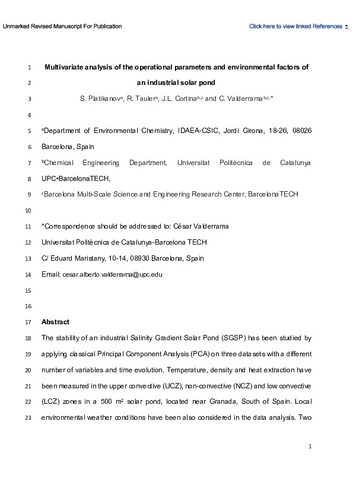Mostra el registre d'ítem simple
Multivariate analysis of the operational parameters and environmental factors of an industrial solar pond
| dc.contributor.author | Platikanov, Stefan |
| dc.contributor.author | Tauler Ferré, Romà |
| dc.contributor.author | Cortina Pallás, José Luís |
| dc.contributor.author | Valderrama Ángel, César Alberto |
| dc.contributor.other | Universitat Politècnica de Catalunya. Departament d'Enginyeria Química |
| dc.date.accessioned | 2021-11-11T11:44:17Z |
| dc.date.available | 2023-07-15T00:28:26Z |
| dc.date.issued | 2021-07-15 |
| dc.identifier.citation | Platikanov, S. [et al.]. Multivariate analysis of the operational parameters and environmental factors of an industrial solar pond. "Solar energy", 15 Juliol 2021, vol. 223, p. 113-124. |
| dc.identifier.issn | 0038-092X |
| dc.identifier.uri | http://hdl.handle.net/2117/356124 |
| dc.description.abstract | The stability of an industrial Salinity Gradient Solar Pond (SGSP) has been studied by applying classical Principal Component Analysis (PCA) on three datasets with a different number of variables and time evolution. Temperature, density and heat extraction have been measured in the upper convective (UCZ), non-convective (NCZ) and low convective (LCZ) zones in a 500 m2 solar pond, located near Granada, South of Spain. Local environmental weather conditions have been also considered in the data analysis. Two operational seasons of the solar pond were considered in order to establish: (1) PCA exploratory models for 2014–2015 operational period and (2) to validate the obtained results during the 2015–2016 operational period. PCA results showed that three factors explained the variance in the monitored stability gradients. The first factor was related to the major effect of the seasonal temperature variation on the entire stability gradient. The second factor, related to the diurnal temperature variation, solar irradiance and wind variables, showed a strong impact on the solar pond temperature and salinity gradients and could affect strongly the UCZ and its border with the NCZ. The third factor affected the stability of salinity and temperature gradients at the LCZ and its border with the NCZ. The latter was related to the increase in temperature and salinity at the bottom of the solar pond, which suggests special attention during the initial formation and settlement of the salinity gradient and the subsequent heat extraction activities. This paper shows PCA modelling as a powerful tool for solar pond operation process surveillance and control. |
| dc.format.extent | 12 p. |
| dc.language.iso | eng |
| dc.rights | Attribution-NonCommercial-NoDerivs 3.0 Spain |
| dc.rights.uri | http://creativecommons.org/licenses/by-nc-nd/3.0/es/ |
| dc.subject | Àrees temàtiques de la UPC::Energies::Energia solar fotovoltaica |
| dc.subject.lcsh | Solar energy |
| dc.subject.other | Principal Component Analysis |
| dc.subject.other | Modelling |
| dc.subject.other | Multiparametric datasets |
| dc.subject.other | Salinity gradient |
| dc.title | Multivariate analysis of the operational parameters and environmental factors of an industrial solar pond |
| dc.type | Article |
| dc.subject.lemac | Energia solar |
| dc.contributor.group | Universitat Politècnica de Catalunya. R2EM - Resource Recovery and Environmental Management |
| dc.identifier.doi | 10.1016/j.solener.2021.05.045 |
| dc.description.peerreviewed | Peer Reviewed |
| dc.relation.publisherversion | https://www.sciencedirect.com/science/article/abs/pii/S0038092X21004151 |
| dc.rights.access | Open Access |
| local.identifier.drac | 32004770 |
| dc.description.version | Postprint (author's final draft) |
| local.citation.author | Platikanov, S.; Tauler Ferré, Romà; Cortina, J.; Valderrama, C. |
| local.citation.publicationName | Solar energy |
| local.citation.volume | 223 |
| local.citation.startingPage | 113 |
| local.citation.endingPage | 124 |
Fitxers d'aquest items
Aquest ítem apareix a les col·leccions següents
-
Articles de revista [210]
-
Articles de revista [2.223]


